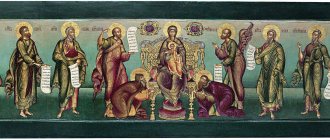Authorship and time of writing
The ownership of the Epistle to St. Paul was not disputed by almost any of the critics, even among the radical ones. There is also no disagreement about the time and place of compilation of the Message. After reconciliation with the Corinthian Christians, St. Pavel stayed with them for several months. In Corinth, he began to prepare for missionary travels to the West. regions of the empire, but first decided to visit Jerusalem and present donations to the Mother Church. Before this trip to Palestine, which filled him with anxiety, the apostle wrote the Epistle to the Romans (end - beginning). The purpose of the message was quite specific. The “Enlightener of the Gentiles” wanted to explain to the Roman Christians the essence of his gospel. This explains the nature of the message, which approaches a coherent theological treatise, although in it the Apostle Paul retains a free dialogical style.
The connection between the teachings of St. Apostle Paul and his life
Epistles of St. the Apostle Paul - these are the fruits of his apostolic zeal; his teachings set forth in them are a complete reflection of his life. Therefore, in order to better understand his messages, you need to study his life well and understand the inner character of his personality. To do this, there is no need to go into an analysis of all the details of his life, known to us from the book of Acts, but we only need to dwell on the inner side of his life and understand those facts that, according to the instructions of the apostle himself, served as a source for him to resolve many issues of Christian dogma and teachings about Christian morality.
Peculiarities
Roman Christians
The epistle does not mention the “Roman Church” anywhere, which has led some exegetes to believe that there was no organized community in the imperial capital at that time. This seemed all the more plausible since the apostle preferred to preach the gospel in cities where the name of Christ had not yet been proclaimed. However, indirect evidence argues against this hypothesis. Apostle Paul knows that the faith of the Roman Christians was “proclaimed throughout the whole world” (Rom. 1:8), and therefore their community was well known. Narrating about the persecution of the city, Tacitus mentions the “huge multitude” of Christians in Rome [1]. It is quite possible that in the world capital of that time there was not one, but several communities, and some areas of the city remained outside the sight of missionaries. This hypothesis also resolves a controversial question: who predominated among the Roman faithful - Jews or converts from pagans (the apostle in the Epistle to the Romans means one or the other)? Paul's intention to come to preach in a city where there were already Christians may have been due to the need to have a stronghold for mission in the West (Rom. 15:20-24).
Chapter 16 Problem
This chapter contains greetings to many persons, apparently well known to the apostle. Among them are Priscilla and Aquila, who were his companions in Ephesus (Rom. 16:3). A number of commentators consider it unlikely that Paul had so many friends in a city where he had never been, and conclude that Chapter 16. there is an addition written for another community (Ephesian?). This hypothesis is plausible, and it would seem to be confirmed by the fact that in a number of ancient manuscripts the word “at Rome” in 1:7 is omitted. This means that there could have been a version of the Epistle to the Romans, transformed by the apostle into a district (conciliar) letter intended for other communities. However, the hypothesis is not accepted by all biblical scholars. Its opponents point to the existence of constant contacts between Rome and other cities of the empire; people whom Paul knew in the East could end up in the capital (especially since, according to Acts 18:2, Aquila and Priscilla were from Rome). The enumeration of these names may be explained by the fact that the apostle was addressing specifically the Christians he knew who lived in a city where he had never been and where he had been longing for a long time (Rom. 1:11).
Other textual problems of Romans
In some lat. There are no manuscripts of the Message, chapters 15-16. They are supposed to have been removed by Marcion in order to bring the Epistle into conformity with his doctrine. Doxology Rome. 16:25-27 is placed in some manuscripts at the end of Chapter 14 (and in the syn. translation). It is possible that it was introduced into Rome after the letter was composed, either by the apostle himself or by one of his disciples.
The importance of the messages of St. the Apostle Paul and the difficulty of studying them
Of all the New Testament sacred writers, St. worked the most in the written explanation of Christian teaching. the apostle Paul, who wrote as many as fourteen epistles. Due to the importance of their content, they are rightly called by some the “second Gospel” and have always attracted attention as St. Fathers of the Church and enemies of Christianity. The apostles themselves, as we saw from the conciliar letter of St. Apostle Peter, did not ignore these edifying works of their “beloved brother, younger in time of conversion to Christ, but equal to them in the spirit of teaching and grace-filled gifts” (2 Pet. 3:15-16). Many Fathers and Doctors of the Church were involved in the interpretation of the messages of St. Apostle Paul. Constituting a necessary and important addition to the Gospel teaching, the epistles of St. The Apostle Paul should be the subject of the most careful and diligent study of every Christian theologian. At the same time, it is necessary to never lose sight of the height and depth of the theological thought of St. the Apostle and that originality of expressions, which sometimes reached the point of incomprehensibility and stopped such great interpreters of the Holy Scriptures as St. Chrysostom, Jerome and Augustine. These letters reflected the extensive learning and acquaintance of St. Apostle Paul with the Holy Scriptures of the Old Testament, as well as the depth in the disclosure of the New Testament teachings of Christ, the fruit of which was a whole series of new words and sayings of a dogmatic or moralizing nature, belonging exclusively to St. to the Apostle Paul, such as, for example, “to be raised with one another,” “to be buried in Christ,” “to put on Christ,” “to put off the old man,” “to be saved by the washing of rebirth,” “the law of the spirit of life,” “another law in the members, rising against the law of the mind.” " and so on. Each message contains the truths and doctrines and moral teachings of the Christian, since Christianity itself is not only a well-known belief - the recognition by the mind of known truths, but certainly the very life of faith, in agreement with this faith.
Content
The message is clearly divided into 5 parts.
- Introduction (1:1-17);
- the universality of sin (1:18-3:20);
- the universal power of saving grace (3:21-8:39);
- life in Christ (12:1-15:13);
- conclusion and greetings (15:14-16:24).
This orderly plan is disrupted only by a special historiosophical excursion about the fate of Israel and pagan Christians (9-11). Mn. commentators suggest that St. Paul inserted text here from his special. messages on this topic, but it is equally possible that his thought naturally deviated from the main current.
First, the apostle gives a terrifying picture of the moral decline of antiquity. society, a picture that is fully confirmed by the evidence of Greco-Roman authors (Petronius, Martial, Juvenal, Suetonius, Tacitus). The apostle examines this corruption of the tongue. world as a result of its rejection of the true God, Who can be known from creation. Lacking a higher revelation, the pagans received conscience as a kind of God's law, but they neglected this law. At first glance, such a verdict on paganism does not go beyond the framework of the attitude of Jews towards foreigners. But from the 2nd chapter. this illusion dissipates. Apostle Paul shows that those who have been given God's Law also live in contradiction to it. In Scripture itself and in real life, Paul finds confirmation that “all have gone astray.” The hypocritical complacency of the Jews, proud of their piety, is worth morals. the debauchery of the pagans. The “Law of Conscience” and God’s written Law were not enough to overcome the common disease of humanity.
Salvation, the apostle further says, comes from Jesus Christ “independent of the law.” It is not achieved by morals. through human efforts, but is given “freely” by the grace of the Savior. Only He can justify people, cleanse them from sin. The power of His “justification” is universal, extending to “those who are circumcised by faith and the uncircumcised by faith.” Anticipating the question whether Scripture is not destroyed by this, the apostle cites the story of Abraham from the Book of Genesis. What is the Old Testament based on? community? Not on Abraham's merits, but on his trust in God, in His promise. For the sake of this faith, circumcision was given as a sign of participation in the community of the faithful. Faith preceded circumcision. But now the object of faith is no longer the promise of God, but the saving feat of Jesus Christ. His mission is broader than the mission of Abraham and Moses. He is a universal mystery. Christ is not the new Abraham and not the new Moses; He is the new Adam. Just as ancient Adam personified fallen humanity, Christ saves and embraces the reborn world, laying the foundation for a new humanity. The power of God is revealed in His atonement. Man needed the law so that he could see morals. ideal and realized his powerlessness to fulfill it. The statutes of the Law only sharpened the consciousness of sinfulness. Paradoxically, the “holy” Law (7:12) aggravated sin, which continued to reign among people.
Sin stood as an obstacle to man's immortality as determined by God. But now the promised eschatological has arrived. era. God appeared in Christ Jesus, and by uniting with Him, the faithful gain new life and a guarantee of immortality. The old man must die and be born a new one, clothed in Christ. But such a person is no longer bound by the obligations of the Law. He is like a widow who became free after the death of her husband. Everything that was former dies with him when he unites with the Crucified and Risen One. From now on, it is not simple obedience to the commandments that animates the believer, but unity with the Sinless One. Faith in Christ opens up a completely new existence for a person. He no longer lives “according to the flesh,” but “according to the Spirit.” And this transformation of man will over time have an impact on the entire creation. In the person of the renewed “sons of God,” she “will be freed from slavery.” Historiosophical excursion ch. 9-11 explains why the Good News was not accepted by Israel as a whole, although they were given “adoption, and glory, and covenants, and laws, and worship, and promises; theirs are the fathers, and from them is Christ according to the flesh, who is God above all.” First, the true Israelites are only the faithful *remnant. Secondly, the “hardening” of Israel providentially contributed to the mass conversion of the pagans. But since the promises are certain, sooner or later “all Israel will be saved.” All this, however, does not mean that God is partial. In the new life, in the life “in Christ,” “there is no difference between Jew and Greek, because there is one Lord for all.”
In the 4th part of Rome, the apostle shows that life in Christ requires a person to be willing to accept salvation. Here the commandments regain their power and meaning. But this is not just a repetition of the Old Testament. commandments, but their transformation in the light of the Gospel. “Be kind to one another with brotherly tenderness...” the apostle calls on Christians, “be fervent in spirit; Serve the Lord, be comforted by hope; be patient in sorrow, constant in prayer; take part in the needs of the saints... Bless your persecutors; bless, not curse. Rejoice with those who rejoice and weep with those who weep. Be of the same mind among yourselves... If it is possible on your part, be at peace with all people” (12:10-18). In other words, the basis of Christian ethics is love. A lover should be lenient towards those who still attach importance to old rituals and prohibitions. “It is better not to eat meat, not to drink wine, and not to do anything that causes your brother to stumble, or to be offended, or to faint” (14:21). This condescension is an act of love, which puts an end to all strife. It is the highest that a person can bring in response to the love of Christ the Savior.
The meaning of the messages of St. Apostle Paul and their subject
Epistles of St. The Apostle Paul are of great importance as part of the New Testament, for in them we find a deep and comprehensive disclosure and clarification of the truths of the Gospel teaching. In addition to some mostly beloved St. by the Apostle Paul of the truths of the faith of Christ, such as, for example, about the meaning of the Old Testament law in relation to the New Testament, about the corruption and corruption of human nature and about the only means of justification before God through faith in Jesus Christ, there is, one might say, not a single particular point in all Christian dogma, which would not find basis and reinforcement in Paul's epistles. Therefore, one who has not studied them in the most thorough manner cannot be a true theologian. Most of the messages are built according to the same plan. They begin with a greeting to the readers and gratitude to God for His providential actions in the place to which the message is addressed. Further, the message is usually divided into two parts - dogmatic and moral. In conclusion, St. the apostle concerns himself with private affairs, makes errands, speaks of his personal situation, expresses his well-wishes and sends greetings of peace and love. His language, lively and bright, resembles the language of the Old Testament prophets and testifies to his great familiarity with the Holy Scriptures.
Literature
- Bogdashevsky (Bishop Vasily), The integrity of the message of St. ap. Paul to the Romans, TKDA, 1904, No. 6;
- Boor Werner de, Epistle to the Romans, Korntal, 1989;
- A life dedicated to a higher purpose. A guide to studying the epistle of St. Paul to the Romans, Buenos Aires (BG);
- archbishop Irenaeus (Klementyevsky), Epistle of St. ap. Paul to the Romans with interpretation, M., 1787;
- Ep. Mikhail (Luzin), Biblical science. Academic readings on St. NT Scripture, vol. 3, no. 2: The Roman Church and the Epistle to the Romans, Tula, 1906;
- Awake to Life: A Paraphrase of Romans, Wheaton, 1983;
- Rozanov N.P., Epistle to the Romans of St. Apostle Paul, TB, vol. 10;
- him, About the message of St. Paul to the Romans, ibid.;
- Tyark O.A., Epistle to the Romans, BVs, 1972, No. 3-6, 1973, No. 1-6, 1974, No. 1-4;
- Ep. Feofan (Govorov), Interpretation of the Epistle of St. Apostle Paul to the Romans, book. 1-2, M., 1890;
- Barrett C.K., Reading Through Romans, L.-Phil., 1977;
- Bruce F. F., The Epistles of Paul to the Romans, Grand Rapids (Mich.), 1963;
- Fitzmeyer JA, Romans, NCE, v.12;
- Hunter AM, The Epistle to the Romans, L., 1957;
- Kertelge K., The Epistle to the Romans, L.-NY, 1972;
- Kasemann E., Commentary on Romans, Grand Rapids (Mich.), 1980;
- Lyonnet S., Le message de l'№p€tre aux Romains, P., 1971;
- id., Les №tapes de l'histoire du salut selon l'Ep€tre aux Romains, P., 1969;
- Maly EH, Romans, Wilmington, 1979;
- Minear PS, The Obedience of Faith, L., 1971;
- Moxnes H., Theology in conflict, Leiden, 1980;
- Stagg F., Galatians, Romans, Atlanta, 1980;
- Zilonka P., Romans, Chi., 1979;










